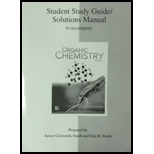
(a)
Interpretation: The carbonyl compound and
Concept introduction: A carbonyl compound (
(b)
Interpretation: The carbonyl compound and amine or alcohol needed to prepare the given compound are to be predicted.
Concept introduction: A carbonyl compound (aldehyde or ketone) reacts with
(c)
Interpretation: The carbonyl compound and amine or alcohol needed to prepare the given compound are to be predicted.
Concept introduction: Acetals are the groups in which carbon atom is bonded with two
(d)
Interpretation: The carbonyl compound and amine or alcohol needed to prepare the given compound are to be predicted.
Concept introduction: Acetals are the groups in which carbon atom is bonded with two
Want to see the full answer?
Check out a sample textbook solution
Chapter 21 Solutions
Study Guide/Solutions Manual for Organic Chemistry
- What product is formed when a solution of A to B is treated with mild base? This reaction is the first step in the synthesis of rosuvastatin (sold as a calcium salt under the trade name Crestor), a drug used to treat patients with high cholesterol.arrow_forwardSafrole, which is isolated from sassafras, can be converted to the illegal stimulant MDMA (3,4- methylenedioxymethamphetamine, “Ecstasy”) by a variety of methods. (a) Devise a synthesis that begins with safrole and uses a nucleophilic substitution reaction to introduce the amine. (b) Devise a synthesis that begins with safrole and uses reductive amination to introduce the amine.arrow_forwardDraw a stepwise mechanism for the following reaction, one step in the synthesis of the cholesterol-lowering drug ezetimibe.arrow_forward
- Draw structures for compounds A–F.arrow_forwardAlthough γ-butyrolactone is a biologically inactive compound, it isconverted in the body to 4-hydroxybutanoic acid (GHB), an addictive andintoxicating recreational drug. Draw a stepwise mechanism for thisconversion in the presence of acid.arrow_forwardDraw a stepwise mechanism for the following hydrolysis.arrow_forward
- Draw the organic products for A and B.arrow_forwardSafrole, which is isolated from sassafras (Problem 21.33), can be converted to the illegal stimulant MDMA (3,4- methylenedioxymethamphetamine, “Ecstasy”) by a variety of methods. (a) Devise a synthesis that begins with safrole and uses a nucleophilic substitution reaction to introduce the amine. (b) Devise a synthesis that begins with safrole and uses reductive amination to introduce the amine.arrow_forwardWhat carbonyl compound and diol are needed to prepare each compound?arrow_forward
 ChemistryChemistryISBN:9781305957404Author:Steven S. Zumdahl, Susan A. Zumdahl, Donald J. DeCostePublisher:Cengage Learning
ChemistryChemistryISBN:9781305957404Author:Steven S. Zumdahl, Susan A. Zumdahl, Donald J. DeCostePublisher:Cengage Learning ChemistryChemistryISBN:9781259911156Author:Raymond Chang Dr., Jason Overby ProfessorPublisher:McGraw-Hill Education
ChemistryChemistryISBN:9781259911156Author:Raymond Chang Dr., Jason Overby ProfessorPublisher:McGraw-Hill Education Principles of Instrumental AnalysisChemistryISBN:9781305577213Author:Douglas A. Skoog, F. James Holler, Stanley R. CrouchPublisher:Cengage Learning
Principles of Instrumental AnalysisChemistryISBN:9781305577213Author:Douglas A. Skoog, F. James Holler, Stanley R. CrouchPublisher:Cengage Learning Organic ChemistryChemistryISBN:9780078021558Author:Janice Gorzynski Smith Dr.Publisher:McGraw-Hill Education
Organic ChemistryChemistryISBN:9780078021558Author:Janice Gorzynski Smith Dr.Publisher:McGraw-Hill Education Chemistry: Principles and ReactionsChemistryISBN:9781305079373Author:William L. Masterton, Cecile N. HurleyPublisher:Cengage Learning
Chemistry: Principles and ReactionsChemistryISBN:9781305079373Author:William L. Masterton, Cecile N. HurleyPublisher:Cengage Learning Elementary Principles of Chemical Processes, Bind...ChemistryISBN:9781118431221Author:Richard M. Felder, Ronald W. Rousseau, Lisa G. BullardPublisher:WILEY
Elementary Principles of Chemical Processes, Bind...ChemistryISBN:9781118431221Author:Richard M. Felder, Ronald W. Rousseau, Lisa G. BullardPublisher:WILEY





